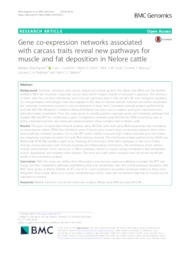Gene co-expression networks associated with carcass traits reveal new pathways for muscle and fat deposition in Nelore cattle.
Gene co-expression networks associated with carcass traits reveal new pathways for muscle and fat deposition in Nelore cattle.
Author(s): VIGNATO B. S.; COUTINHO, L. L.; POLETI, M. D.; CESAR, A. S. M.; MONCAU, C. T.; REGITANO, L. C. de A.; BALIEIRO, J. C. C.
Summary: Positively correlated with carcass weight and animal growth, the ribeye area (REA) and the backfat thickness (BFT) are economic important carcass traits, which impact directly on producer's payment. The selection of these traits has not been satisfactory since they are expressed later in the animal's life and multigene regulated. So, next-generation technologies have been applied in this area to improve animal's selection and better understand the molecular mechanisms involved in the development of these traits. Correlation network analysis, performed by tools like WGCNA (Weighted Correlation Network Analysis), has been used to explore gene-gene interactions and gene-phenotype correlations. Thus, this study aimed to identify putative candidate genes and metabolic pathways that regulate REA and BFT by constructing a gene co-expression network using WGCNA and RNA sequencing data, to better understand genetic and molecular variations behind these complex traits in Nelore cattle.
Publication year: 2019
Types of publication: Journal article
Observation
Some of Embrapa's publications are published as ePub files. To read them, use or download one of the following free software options to your computer or mobile device. Android: Google Play Books; IOS: iBooks; Windows and Linux: Calibre.
Access other publications
Access the Agricultural Research Database (BDPA) to consult Embrapa's full library collection and records.
Visit Embrapa Bookstore to purchase books and other publications sold by Embrapa.

